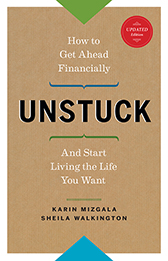Director, Communications
At Money Coaches Canada, we pride ourselves on “Taking the Worry out of Money”. We help our clients use their resources to live their best lives and map out how to achieve their highest goals, while respecting their values and preferences and preparing for the unfortunate and unexpected. It involves a good amount of introspection, to understand who you are and what’s important to you and communicate that to your “life team” – your loved ones and the professionals you hire to help make your plan a reality.
 So, when we encountered Dr. Daren Heyland, a critical care physician, researcher, Professor of Medicine at Queen’s University and creator of Plan Well Guide, which has a similar mission but focused on healthcare, we thought we’d take a closer look.
So, when we encountered Dr. Daren Heyland, a critical care physician, researcher, Professor of Medicine at Queen’s University and creator of Plan Well Guide, which has a similar mission but focused on healthcare, we thought we’d take a closer look.
I had the opportunity to ask Dr. Heyland some questions about Plan Well Guide: what it is, who it’s for, and why it’s so important, as well as work through the Guide myself.
What is Plan Well Guide?
“To live well, age well, and die well, you need to Plan Well” – Plan Well Guide tagline
Dr. Heyland and his team created Plan Well Guide to help Canadians prepare for serious illness or injury, specifically how to communicate their values and preferences around their medical and personal care when they are unable to do so effectively.
“I am a critical care doctor and my lived experience was that people would arrive near or at the end of life needing critical care services and were ill-prepared for the decision making that happens when you are seriously ill,” Dr Heyland says. “For most patients, they are too sick to participate in decision-making so we collar the family member to help us make life and death decisions. They experience tremendous stress and suffering because they are ill-prepared for this role.”
In addition, his research has shown that patients are frequently given treatments that they didn’t want but were unable to communicate that to their care team. His goal in creating Plan Well Guide is to “reduce human suffering, experienced by both patient and family, if we better prepare people for future serious illness decision-making.”
The Guide was created for adults of all ages, since serious illness or injury which impairs one’s ability to communicate can happen at any time. It helps summarize a patient’s wishes in writing – while empowering an authorized representative to provide greater depth and detail – which is then more easily and consistently communicated to loved ones and a care team.
This last point speaks very personally to me. I encountered this with my mother last year, who was in and out of the hospital multiple times with an infection that, among other things, affected her ability to communicate. Due to COVID-19 restrictions, I was unable to be with her in hospital to advocate for her and communicate her wishes to her acute care provider (who could be a different person with every shift change), which meant I found myself having the same emotionally fraught discussion repeatedly with multiple doctors, nurses, therapists, and social workers. It was stressful and exhausting, and I was always anxious about whether I had effectively, consistently and fully communicated my mother’s wishes regarding her treatment.
I was fortunate. My mother lived with me prior to her illness, and we were very close. I was aware of her wishes with respect to her care during a serious illness, what “quality of life” meant to her, and there were no dissenting voices from siblings or other family members when it came to her treatment and what she “would have wanted”.
Unfortunately, that is not often the case. It likely won’t be the case for me if (reality check… WHEN!) I become seriously ill or injured. So, I took the Plan Well Guide for a spin myself.
When signing up, the website offers the unusual promise “to provide you with all the tools possible to live a long life of high-quality, and experience a peaceful and high-quality death for you and those closest to you.”
Talking about illness and death are not things that normally get people excited, but as one of the two classic inevitabilities of life, it’s important to have the conversation – with yourself, and your loved ones – and the Plan Well Guide walks you through many questions you may not have considered.
The Plan Well Guide actually consists of 2 guides.
- Guide to EXPLORING – Your Authentic Values & Informed Treatment Preferences
- Guide to ENTRUSTING – Your Values & Preferences to a Representative
The EXPLORING guide is free, and helps clarify medical treatment options, identify and communicate your values, and generate a “Dear Doctor” letter to explain those values and treatment preferences to your medical care provider and loved ones when you can’t.
This guide takes about 20 minutes to complete – although there are supplemental videos and information that will add to that – and you are walked through 17 steps to help you understand:
- The difference between End-of-Life Planning and Advance Serious Illness Planning (ASIP)
- The benefits of engaging in ASIP
- The different types of care one may receive when seriously ill
- Is Cardiopulmonary Resuscitation (CPR) right for you, with some surprising statistics regarding patient survival after CPR
- Considerations if you are a resident in long-term care, or helping someone who is
- The type of serious illness care that best fits your values and preferences
- What health states you personally consider unacceptable, or “worse than death”, as well as questions, considerations, or concerns that you would want your representative to discuss with your doctor
The second guide, ENTRUSTING, is about choosing, educating, and empowering an individual to represent your values and preferences for medical and personal care on your behalf, including understanding the roles and responsibilities of that person.
Why two guides?
Dr. Heyland explains “Our initial focus was on preparing people for thinking and planning ahead for their medical care if they were incapacitated. But as we got into this space, we realized that no one was really preparing people to think ahead and plan ahead for their personal care if they were alive and incapacitated. As society ages and we face more diseases like Alzheimer’s dementia, it is highly probable at some time that a person will lack capacity to make decisions about where they live, what they eat, who visits them, who has access to their medical records, etc. So we began developing the tools and educational strategies to help people think ahead and plan ahead for their personal care as well.”
Imagine if you were incapacitated for an extended period and your representative had to organize your daily home life. There are SO many aspects of your life they would need to understand, such as how much time and money you want them to spend on your care, whether you would prefer a family caregiver or professional care, where you would live, what you enjoy doing and with whom, your dietary preferences, and religious or spiritual observances that are important to you, to name just a few.
With such an important job, the guide highlights several important considerations when choosing your legal representative. Ideally, you would know your candidate for legal representative as well as they know you!
This guide includes creation of a document for your province or territory to legally empower your representative – and if desired a backup – to provide medical and personal care instructions on your behalf, and even includes the option to inform them of their impending legal appointment via the Plan Well Guide platform. The Power of Attorney (POA) for Personal Care in Ontario which I selected is a “springing” POA that comes into effect upon determination of incapacity and refers to the “Dear Representative” letter, created by working through this guide, for details of one’s preferences.
Also included is a scannable wallet card you can carry which links to your Dear Doctor letter (created in the EXPLORING guide) and your representative’s contact information, in case of emergency.
The ENTRUSTING guide costs $99 + tax, and there is a 30-day money back guarantee.
I asked Dr. Heyland what the future developments he envisions for the Plan Well Guide.
“We are working on a module or a guide that will help people select, instruct and provide oversight to the person who will manage their finances when they are unable,” he said. “The other cool thing we are doing is that we have created a virtual reality video to help people see and ‘feel’ what it is like to be thrust into a life and death decision-making encounter in the ICU setting. They come away from that virtual experience motivated to do their advance serious illness planning.”
A 2D recording of this virtual experience is one of the resources found within the current Plan Well Guide, and the third guide is expected later this year.
The Plan Well Guide is an excellent tool for Advanced Serious Illness Planning. It effectively facilitates a conversation about that which we’d rather not talk about – our fragility and the likely prospect of incapacity – and motivates us take the steps necessary now to ensure we continue to live our best lives, on our terms, even when we are seriously ill and unable to advocate for ourselves.
Check it out at https://www.planwellguide.com



